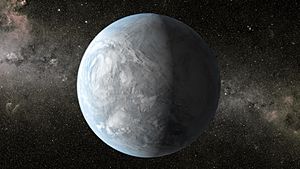Kepler-62e facts for kids
Imagine a planet far, far away, circling its own star! That's Kepler-62e. It's a special kind of planet called a super-Earth. This means it's bigger than our Earth but still rocky, not a gas giant like Jupiter. Kepler-62e is an exoplanet, which means it orbits a star other than our Sun.
This amazing planet is found in the habitable zone around its star, Kepler-62. The habitable zone is like a "sweet spot" where the temperature is just right for liquid water to exist on a planet's surface. And liquid water is super important for life! Kepler-62e is over 1,200 light-years away from us, in the direction of the Lyra constellation. It was discovered in 2013 by the Kepler Space Observatory, a special telescope that looks for planets outside our solar system.
What is Kepler-62e Like?
Kepler-62e is much larger and heavier than Earth. It's about 1.6 times (or 160%) the size of Earth. It's also nearly 4.5 times (or 450%) as heavy! Because of its size and weight, scientists call it a "super-Earth."
Scientists think Kepler-62e might be an ocean world. This means it could be almost entirely covered by a deep ocean. Imagine a planet with no land, just water! It might also have cloudy skies, making it feel warm and humid, a bit like a tropical place on Earth.
The Habitable Zone Explained
The habitable zone is often called the "Goldilocks Zone." Just like Goldilocks wanted her porridge to be "just right," planets in this zone are not too hot and not too cold. This perfect distance from their star allows for temperatures that could keep water in liquid form.
If a planet is too close to its star, water would boil away into steam. If it's too far, water would freeze into ice. So, finding a planet like Kepler-62e in the habitable zone makes it a very exciting place for scientists to study. They want to know if it could support life, or if it ever did.
Images for kids
-
Confirmed small exoplanets in habitable zones (artist's impressions).(Kepler-62e, 62f, 186f, 296e, 296f, 438b, 440b, 442b)
See also
 In Spanish: Kepler-62e para niños
In Spanish: Kepler-62e para niños



